Table of Contents
- Artisanal Vodka And The Undying Loyalty Of Vodka Drinkers
- A Brief History Of Vodka: Russia, The Moscow Mule, And Flavors
- No Longer A Completely Neutral Spirit: The New Law Of Vodka In The United States
- What Is Vodka Made Of?
- Production Of Vodka
- Types Of Vodka
- How To Drink Vodka: Sipping Vs. Mixed Drinks
- What To Drink: Brands Of Vodka And Recipes
- Common Questions And Facts About Vodka
- So What Shall It Be, Dear Vodka Drinker?
But that’s changing with the introduction of new distilleries and redefined rules on just what qualifies as vodka.
This month, we’ve talked with Devon Trevathan of Liba Spirits and Veronika Karlova of Girls Drink Vodka to understand the delicious changes the industry is seeing around this spirit and to discuss all the other elements surrounding vodka– including cocktails!
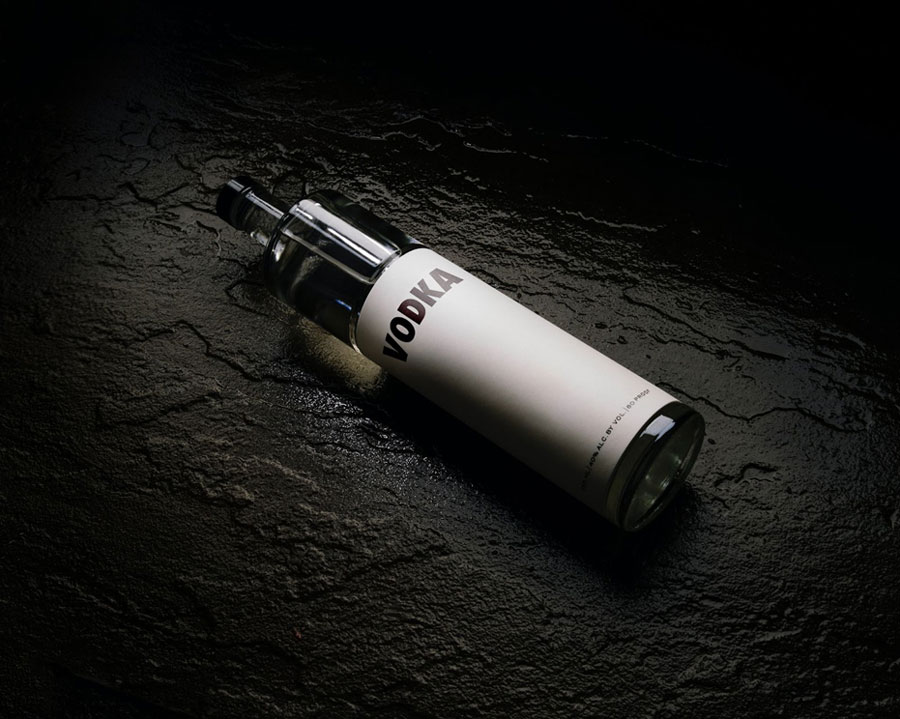
ARTISANAL VODKA AND THE UNDYING LOYALTY OF VODKA DRINKERS
Until 2020, the U.S. rules of vodka included that it had to be colorless, odorless, and tasteless. Not only was that a big ask (and a little boring, in our opinion), but it’s common knowledge that vodka was never actually odorless and flavorless.
“That’s the beauty of vodka. […] It had this very restrictive part of its definition, its standard of identity, in the United States.[…] But you can actually make it from a huge variety of sources. […] Vodka inherently has a lot of potential for a great variety of different flavors and products that could be very exciting, but it was kind of squashed by the definition because why would anybody want to sit there and sniff through a bunch of neutral products? That’s just not exciting.” –Devon Trevathan
Originally, vodka wasn’t meant to be so neutral, though. It had some richness and character to it and didn’t need to be odorless and flavorless (being colorless was always pretty standard).
But after the inventions of the column still and charcoal filtration, super-neutral vodka that was filtered and distilled as much as possible became the norm. And that’s probably what you think of when you think “vodka.” Sure, it was a smoother vodka with cleaner flavors, but it was a bit… well, dull.
These days, however– thanks in part to the new law in the U.S.— we’re being treated to a more complex spirit with “character.” With these, you still get a high-quality spirit with a smooth finish and clean taste, but there are added elements that make these expressions so much more interesting.
These are often referred to as “vintage” vodkas— not that they themselves are old but that they are trying to capture qualities reminiscent of vodkas from earlier times.
“I have a tendency to romanticize historical versions of a lot of different products, but I do think that if we can now, using all of the technology that we have and all of the expertise, attempt to produce a vodka kind of in the same way they were doing before it changed and before the neutrality thing became so much a part of it, potentially you could make such gorgeous spirits.” —Devon Trevathan
While it was once shunned in bars thanks to atrocities like the “appletini” (an apple martini, for those fortunate enough to be unfamiliar), many bartenders now see working with vodka as a welcome challenge, building delicious cocktails around this delicate spirit.
And the truth is, vodka consumption never dropped despite the negative reputation it endured. In researching for this article, I found that only tequila* has a higher Internet search rate than vodka. And, as of 2019, vodka was still the highest-selling spirit in America.
(Note*: For what it’s worth, whiskey and vodka are essentially tied around 200,000 hits a month, garnering the same amount of inquiries as gin and rum combined).
THE ESSENTIAL HOME BAR TOOLS YOU DEFINITELY NEED
If you’re just beginning to stock your bar at home, you’ll need these simple tools to get started. From here, you can add more to your collection as your cocktail-making endeavors become more advanced.

A BRIEF HISTORY OF VODKA: RUSSIA, THE MOSCOW MULE, AND FLAVORS
Centuries of debate between the Polish and the Russians have not cleared up who originally invented vodka. The rich history of vodka is interwoven between both countries, although it is undeniable that Russia is known for its vodka.
However, both countries named this beverage after their word for water (it roughly translates to “little water” in both Polish and Russian), indicating just how important–or how drinkable– they found the spirit.
The first version of vodka was used as a cleaning product (which is how we use it here at A Bar Above— and it’s great for disinfecting after a lice outbreak, not that I would know from personal experience or anything). It was also originally used for medicinal purposes rather than for drinking.
“Historically, vodka, before even the invention of the column still, tasted completely different. It was something called polugar bread wine […] It had a lot of character; it was normally even flavored because the quality of the spirit wasn’t so good. They would try to mask the original spirit with a kind of, like, herbal infusion. Probably the most famous infused vodka we know is Zubrowka, which is flavored with bison grass, which regionally, was obviously created because of the kind of, like, medicinal purposes. Vodka was a cure for everything.” –Veronika Karlova
That is until, according to Russian legend, a monk of the Chudov Monastery in the Kremlin used his exploratory knowledge of distillation to create ‘the first’ recipe for vodka, beginning a deep association between Moscow and vodka, which soon swept the nation. (Note: We aren’t exactly sure who developed the first drinking vodka.)
In fact, it became so popular that in the 16th Century, Ivan “the Terrible” actually subsidized a war in the 1600s with government-run bars! So vodka being the nation’s drink of choice became a useful way for the government to collect much-needed funds.

VODKA’S RISING POPULARITY DUE TO TECHNOLOGY AND NEW COCKTAILS
Originally, vodka was made in pot stills, but distillation advanced greatly with the column still, making vodka more accessible and popular. However, the invention of new distillery equipment didn’t make other countries take notice quite yet. Vodka didn’t find international success until the 1940s with the invention of the Moscow mule.
“Any conversation about vodka’s worldwide spread has to start in 1940s Hollywood at the Cock ‘n’ Bull Saloon. The legend goes that John G. Martin of Smirnoff and Jack Morgan of the Cock ‘n’ Bull came up with the drink to help Martin move his vodka and Morgan move his bar’s overstock of ginger beer. Morgan’s girlfriend had recently inherited a copper factory, and the iconic mule mug was born.
We don’t know exactly when vodka, ginger beer, and the copper mug all came together, but by 1947, Martin was running a kind of viral ad campaign where he would take Polaroid pictures of bartenders holding a bottle of Smirnoff and a copper mug.” —Michael Lindgren, bartender and writer
In the 90s and early 2000s, vodka’s popularity increased greatly, and there was a bit of a “martini craze,” so-to-speak, which was an umbrella for all kinds of flavored martinis and popular vodka cocktails like the Cosmopolitan cocktail, lemon drop martini, chocolate martini, and the one we’ll just call the “passion fruit martini.”
Companies like Stoli and their flavored vodkas became all the rage, the antithesis to the modern craft cocktail movement and probably one big reason why vodka earned such a bad reputation around 2004-ish. Immensely popular with drinkers, it was a good time to be in the flavored vodka business– but it definitely damaged the spirit’s credibility.
Coupled with the rising popularity of whiskey (fueled by the nostalgia for the drinks of yesteryear) and bartenders’ disdain for flavored vodkas, the spirit lost much of its credibility– though not its consumer base.
(True story: I went to a speakeasy here in San Diego circa 2005 where they did not stock any vodka and give you a little attitude if you dared order this spirit. Instead, they would serve you gin, which just shows how bartenders reacted to the sweet-vodka-drink trend.)
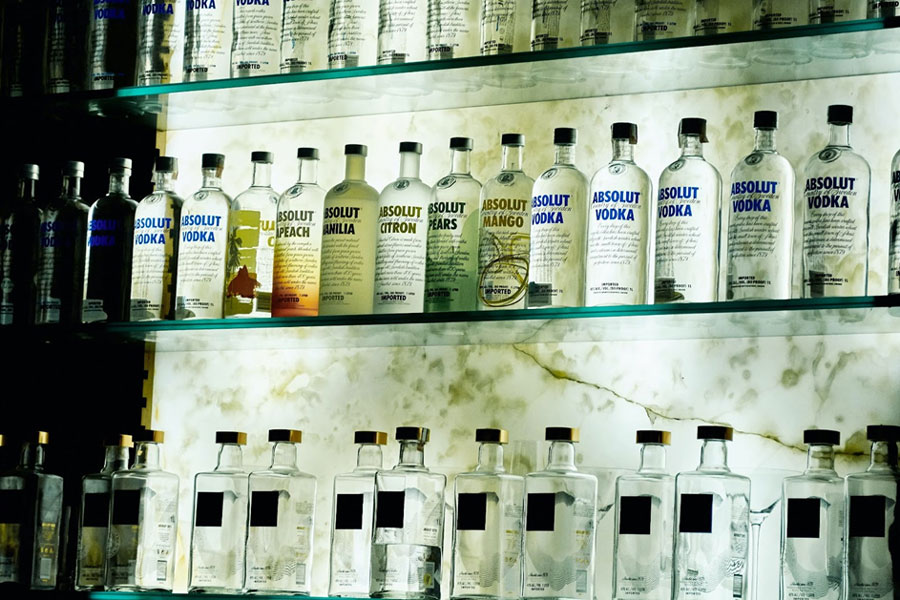
NO LONGER A COMPLETELY NEUTRAL SPIRIT: THE NEW LAW OF VODKA IN THE UNITED STATES
Post-Prohibition, consumers began wanting a mixed drink rather than straight sipping spirits. At the time, Smirnoff vodka was being marketed as “white whiskey” (not to be confused with the actual product now known as white whiskey) with no taste or aroma, which consumers coveted for mixing.
According to the book King of Vodka, this desire for a “characterless vodka base” led to the qualifications set up for the Alcohol and Tobacco Tax and Trade Bureau (the TTB) requiring vodka to be a neutral spirit without distinctive odor, taste, or color. And this held as the legal definition and standard identity of vodka in the U.S. until 2020.
Which begs the question: How do you distinguish yourself as a brand when you’re making a spirit that is literally supposed to have no noticeable qualities?
Answer: Marketing
The truth is the “super-premium vodkas” on the shelf probably aren’t that much better (if at all) than the cheaper stuff. But it’s all about advertising.
When your product isn’t really that different from others on the market, you have to get creative with branding. (Hence the competition for craziest flavored vodka.) But this costs money, which doesn’t leave much room for smaller producers.
Fortunately for the craft cocktail community as a whole, the TTB wasn’t really regulating “vodka with character,” so smaller distilleries were making something different, something more complex under the vodka umbrella.
“Some renegade distillers were producing vodkas with character over the last, I would say, probably decade plus. Because there was that new craft distilling scene, and there was interest in what you as an individual in the craft community could put worth. What’s your take on these categories? And so some people were doing vodkas with character.” –Devon Trevathan
The problem: These weren’t the vodka that consumers expected. But with time, vodka with character has grown in popularity, leading the TTB to get with the times and modernize how they defined spirits.
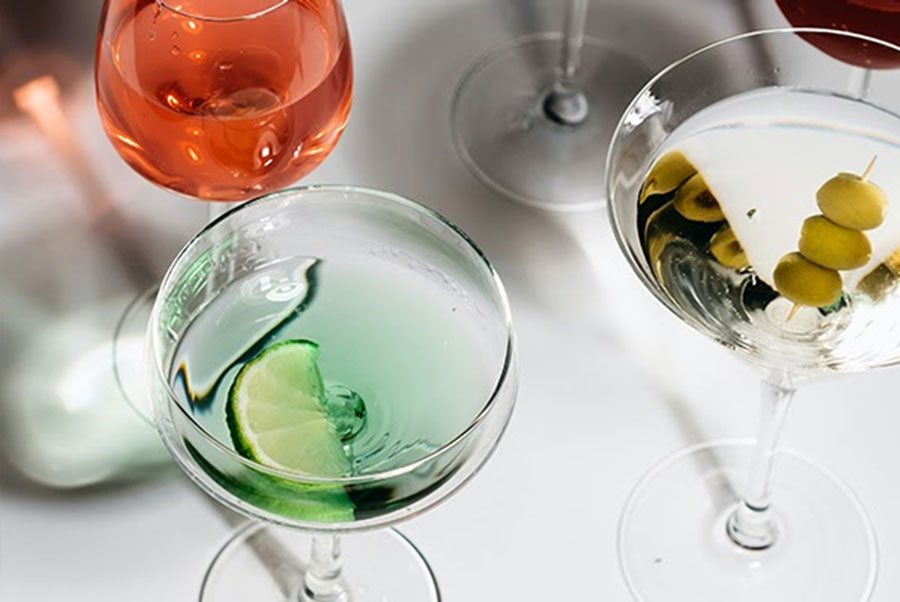
VODKA’S NEW DEFINITION:
- Can be treated with up to 2 grams of sugar per liter
- Can be treated with up to 1 gram of citric acid per liter
- Can only be stored in paraffin-lined wood barrels, as to not affect the character
- Still must be distilled from any material at or above 95% alcohol by volume (190 proof)
- If bottled, must be bottled at not less than 40% alcohol by volume (80 proof)
“To me it’s such a move in the right direction. For vodka, obviously, but also I think for the spirits industry as a whole, this kind of removal of a definition that didn’t serve the category or the entire industry. Because, to me, what is and what will always be interesting about spirits is how you can create a character or flavor just from the raw ingredients that you’re using and then carry that through and concentrate it into the final product.” –Devon Trevathan

Photo by Carolina Grabowska via Pexels
NEW VODKA: FLAVORFUL VS. FLAVORED
When you talk about flavorful vodka with character, you run the risk of people thinking you mean flavored. Of course, these are two totally different things:
- “New” (or really “vintage”), flavorful vodka: Creating flavor from the base, raw material– It is unflavored vodka that still has hints of flavor. Does that make sense?
- Flavored vodka: Adding artificial flavoring after the distillation process– typically with heavy-handed, super-sweet results.
Because brands went overboard with flavored vodka (we’re looking at you, birthday cake), the term “flavorful” may be kind of tarnished. We hope that changes as more distilleries play around with vodka, though!
Not that we necessarily blame commercial distilleries for trying to distinguish themselves from all the other brands on the shelf.
But yeah, it got out of hand.
As we move forward in this article, though, my references to flavorful or character-full vodka is not the same as “flavored.” Hopefully, consumers can get past that association to give newer distilleries a chance to prove themselves.
“Its reputation, the perception, that’s such a huge part of it because people need to become comfortable with the idea of flavorful vodka– and this is flavorful, not flavored– ‘cause there’s even that hump to get over. Because when you talk about… “character” is kind of a highfalutin term to some people, so maybe you don’t want to use that. Maybe you want to talk about the flavor of this vodka, and you’re talking about the flavor that’s derived from the way you were handling the raw materials and the bacteria or yeast metabolism through the fermentation. That all came through in your distillation, and you have a character-full, flavorful vodka.” –Devon Trevathan

WHAT IS VODKA MADE OF?
OK, so now that we understand the history and cultural significance, let’s talk basics. First, vodka is an alcohol consisting mostly of water and ethanol— distilled from fermented material such as grains– and must be at least 40% alcohol by volume (80 proof).
Vodka is an easier spirit to make than pretty much any other because it can be distilled from any fermented starch- or sugar-based material. This leaves a lot of room for interpretation!
Typically, these materials are plant-based, but leave it to the master distiller of today to get creative with distilling products. Some of the more popular and traditional base materials include these:
- Wheat
- Rye
- Corn
- Potato
- Sugar beet
While traditional, neutral vodkas are still quite successful and popular, there is definitely a new version of this spirit.
“Traditionally, it was not very interesting. It really has such a long and storied history, but talking about just for clarification’s sake, the last 25 years, not a very interesting spirit to talk about because it was neutral. A friend of mine coined the term ‘neutral monster.’* That’s what it was. It was a huge, huge category of spirit that was largely indistinguishable. And once you start to get into spirits and distillation and you’re curious about different producers and their products, why are you going to go deep-dive into a category that, by definition, is odorless, flavorless, colorless, and has no character? How do you differentiate? Why is that interesting? It was uninteresting for so long, and that’s too bad because it doesn’t have to be.” –Devon Trevathan
(*Note: Devon’s buddy she references is Jason Zeno from Porchjam Distillery.)
And in the spirit (no pun intended, I swear) of redefining what it means to be vodka, modern distillers love to play with the base ingredient. Here are some of the more unique bases we’ve heard of lately:
- Quinoa
- Honey
- Cow’s milk
- Butter
- Grain and apples from the Chernobyl site (Their website doesn’t specify which products are used, but Devon mentioned grain in her interview, while I’ve read various stories referencing apples. Either way, would you dare drink this particular spirit?)
- Discarded coffee fruit
- Baked goods donated to food banks
- CO2— Yes, you read that correctly
- Mare’s milk (Say what?!?)
In fact, these creative distilleries inadvertently helped change the U.S. law regarding vodka’s qualities. Because newer distillers kept making vodka with character that didn’t fit the traditional mold, the law around the final product was reassessed to allow more flavor and smell.
Now small, regional distilleries can get back to a more historically accurate style of vodka that is not so neutral– ones that offer body, mouthfeel (butter, anyone?), and distinct flavor notes.
“Finally you can appreciate that taste. […] And those distilleries, families have been producing for many years or even centuries and now, finally, […] that farm-to-bottle approach is really appreciated.” –Veronika Karlova

PRODUCTION OF VODKA
In their interviews, Veronika and Devon both mention pot and column stills a few times, discussing the technology and how column stills have made distilling more accessible to producers. Here are the main differences between the two types of stills:
POT STILL
- Made of copper
- Produce lower-ABV spirits (5-16% or so)
- Run on batch distillation where separate batches of distillate are made
COLUMN STILL
- Made of copper and/or stainless steel
- Produce higher-ABV spirits
- Run on continuous distillation where the still is re-fed, and one batch is filtered out while another batch begins to be distilled without any interruption or stopping of the still (making it more efficient)
VODKA FERMENTATION & DISTILLATION PROCESS
Let’s quickly break down the production process to better understand what exactly goes into your spirit:
- A high-starch or sugar material (or a blend) is fermented to create a low-ABV alcohol by combining it with yeast. As I mentioned, grain vodka is the most common (Note: sometimes these ingredients are called cereal grains).
- This fermented alcohol (or “wash”) is then heated up in a still to raise those ABV levels.
- During this process, alcohol is separated from water, and the resulting spirit has an ABV of approximately 95-96%.
- This super strong spirit is then put through a filtration process— typically using charcoal– to remove impurities and create a more neutral taste. Some people say extra filtration creates a super smooth vodka… But others chalk that up to marketing.
There are even brands that filter their vodka through diamonds (both real and synthetic)!
- Water is added to the alcohol before it is bottled; typically, the final spirit will end up around 40% ABV. You’ll definitely see some producers bragging about their use of natural spring water because the type of water used is said to affect the over product, potentially creating a smoother vodka with a richer mouthfeel.
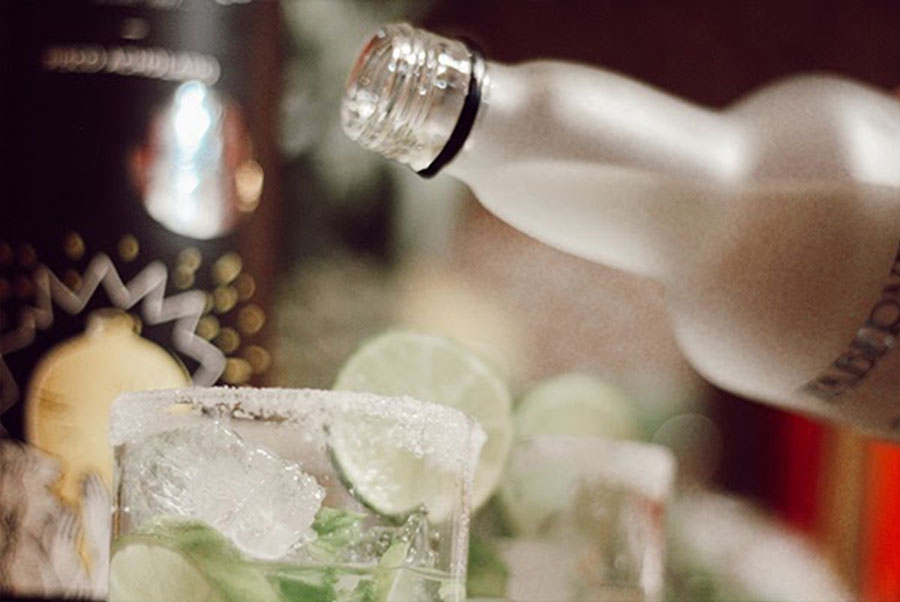
TYPES OF VODKA
Unlike whiskey, which has multiple categories and classifications, vodka is categorized by what it is made of or whether it has flavor, and there are very few types; however, a specific distinction is not listed on its label (such as bourbon, Irish whiskey, Scotch, etc.).
I’ve seen it argued that there are 2-6 types of vodka; like everything concerning alcohol and cocktail culture, every distiller and bartender probably has a different opinion, so it’s best not to take it with a grain of salt.
So don’t take our word that these are the end-all-be-all styles, but you can theoretically break them down into these simple, overlapping categories as you see fit (the first two being essentially undisputed):
- Neutral: Neutral vodka is, well, neutral– It follows a traditional Polish or Russian recipe and does not contain additions. (Sometimes these are called plain vodkas.)
- Flavored: Just what it sounds like, these have added flavor so that they are no longer neutral (think watermelon, mint, raspberry, etc.)
- Grain vodkas: These are vodkas made specifically from traditional grains such as corn, wheat, rye, and barley. This distinguishes vodkas made from grains vs. those made from potatoes.
A lot of people are concerned about which brands use grains in order to avoid gluten— But since vodka is distilled and filtered multiple times, gluten (and any other protein or nutritional value) is separated out, so you shouldn’t have to worry too much if you are gluten-free.
- Regional vodkas: Since certain countries and locations often prefer to use a particular ingredient in their distillation, you can categorize vodkas by where they come from.
- Vodka with character: This term is used to describe spirits that aren’t completely neutral but rather have interesting flavor, terroir (rich flavor elements caused by the environment where a spirit– typically wine– is produced), or other characteristics due to the unique ingredients they include.
“Most of the brands that are promoting terroir are actually potato-based brands because […] for some reason, potatoes are a much better ingredient to use when you try to achieve different character because potatoes deliver those creamy notes, earthy notes, and kind of vegetal notes at the same time. […] Something like wheat doesn’t deliver that kind of character.” –Veronika Karlova
- Raw material: Related to the grain or vodka categories, this category can include many different materials, including some of the more inventive ingredients recently used, like whey.
INFUSIONS AND FAT WASHES
These aren’t exactly “types,” but it’s worth noting that the art of vodka infusions and fat washes holds a place in the craft cocktail world. Using a neutral spirit, you can create your own delicious vodka with interesting qualities using these techniques.
It’s different than adding artificial flavor, as you’re soaking natural materials (herbs, fruit, bacon, what-have-you) in the base spirit to create a vodka with notes of your ingredient rather than a really strong, artificial flavor.
Some people consider fruit vodkas to be their own category– These have simply been infused with fruit, so I personally prefer to use the broader category of infusions. Again, the way you categorize this spirit is a matter of personal preference.
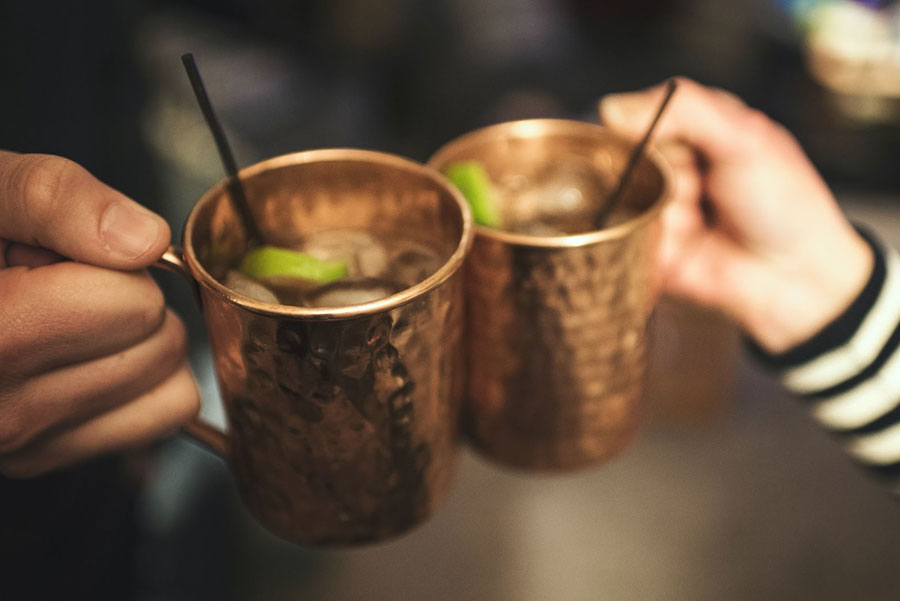
HOW TO DRINK VODKA: SIPPING VS. MIXED DRINKS
Let’s be honest: In America, it seems like we don’t always get it right when it comes to vodka. We typically mix vodka in cocktails, but the most common way that people drink it in other countries is by sipping it. As Veronika Karlova explains about her native country of Slovakia,
“You definitely don’t mix vodka. [….] You have a bottle of vodka on the table, and then you have shot glasses, and that’s how you drink it. So normally, it is either fridge temperature or freezer temperature, so it’s kind of chilled, and then there is a lot of food on the table at the same time, so it kind of allows you to go through that all-night drinking vodka, doing shots of vodka while you’re eating all sorts of pickles and homemade sausages and cheese and stuff like that.” –Veronika Karlova
So the next time you host a cocktail party, consider this Eastern European tradition instead of making cocktails!
VODKA TRADITIONS THROUGHOUT TIME AND THE WORLD
While we Americans tend to simply distill and consume our alcohol (oftentimes mixed into cocktails), other countries can have very rich traditions, especially surrounding vodka. When Chris talked with Veronika Karlova earlier this month, she briefly walked us through the beautiful ritual of her native Slovakia.
She described how, in Slovakia, every household makes their own vodka. All the neighbors on a street come together to judge the best vodka, and then they compete against other streets in their town.
Vodka is also used as a celebration when a child is born:
“When a child is born, every father would dig up a hole and bury a bottle of his homemade vodka in the garden, and then either on your 18th birthday or the day of your wedding, they would dig it up and drink it to celebrate.” –Veronika Karlova
(If you know of other countries that have similar traditions, please tell us in the comments!)
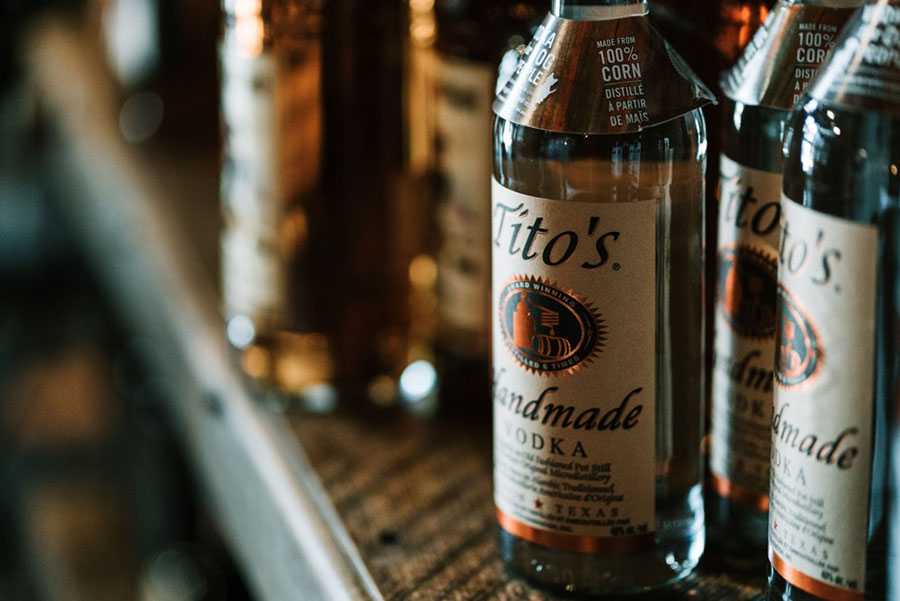
WHAT TO DRINK: BRANDS OF VODKA AND RECIPES
Of course, we know that sipping a spirit isn’t for everyone, so I won’t leave you hanging without vodka cocktail recipes! Let’s talk about which brands of quality vodkas to try first, and then I’ll walk you through some delicious mixed drinks to make at home.
THE BEST VODKA BRANDS AT EVERY PRICE POINT: $20 AND UNDER
- Wyborowa: One of the more traditional, iconic vodkas from Poland, Wyborowa (pronounced “Vih-boar-oh-vuh) is distilled from rye. According to Veronika, it is the typical “house pour” throughout Europe because of the combination of reasonable price point and high quality.
- Burnett’s vodka (by Heaven Hill Brands): A famously cheap vodka, grain-based Burnett’s actually won a recent competition that Veronika judged– which surprised me since it was mostly known in the 2000s for its super-sweet flavored vodka! (Some of their notable flavors include blue raspberry, whipped cream, vanilla, and sweet tea.)
- Finlandia: Distilled from barley and boasting the use of pure glacial water from Finland, this is one of Veronika’s top picks.
- Ketel One Vodka: Certainly one of the more well-known brands in America, Ketel One is distilled from wheat and produced by the Nolet Family Distillery, which has a long distilling heritage (since 1691!) that gives this brand a lot of credibility.
- Luksusowa: Chris’ “well” pick, Luksusowa (pronounced look-soo-so-vuh) is a Polish spirit distilled from potatoes.
VODKA IN THE $20-40 RANGE
- East London Liquor Company: From a newer distillery based in London, this craft vodka is made from wheat and is described as “creamy,” with notes of vanilla– an example of “new” vodka with character. It can be difficult to find in America, so the $30 price tag goes up with shipping fees.
- Reyka: Veronika considers this Icelandic spirit with a clean finish to be very high-quality at a decent price point. If you look around a bit, you can even find it for under $20 here in the U.S.
- Fair: Made from quinoa, this is one of those unique alcohols I mentioned earlier. It’s also organic and fair-trade, with a price of around $30 in the States.
- Cape Grim 666: What’s up with the ominous moniker? Made in Tasmania with water from Cape Grim (hence the devilish name), Cape Grim 666’s original expression is made with malted barley grain. But they also have an expression called Autumn Butter Vodka, made with real butter for a creamy finish.
- Kavka: This brand mixes wheat and rye and then adds an apple-plum distillate. The end result is a historically-traditional Polish vodka with enhanced character from its fruity, subtle sweetness.
- Karlsson: There’s no denying this is Chris’ top pick of potato vodka when he mentions it in not one, but two, interviews. It can be difficult to find, so if you happen upon some, send us a bottle, will ya?
VODKA OVER $40
- Barr Hill: From the U.S. distillery Caledonia Spirits, this unique vodka is made from honey and runs about $60.
- Beluga: While the original expression is typically around $30, they have a gold line edition ($80-90) that includes a small hammer for opening the package and that Veronika describes as “balanced and slightly sweet.”
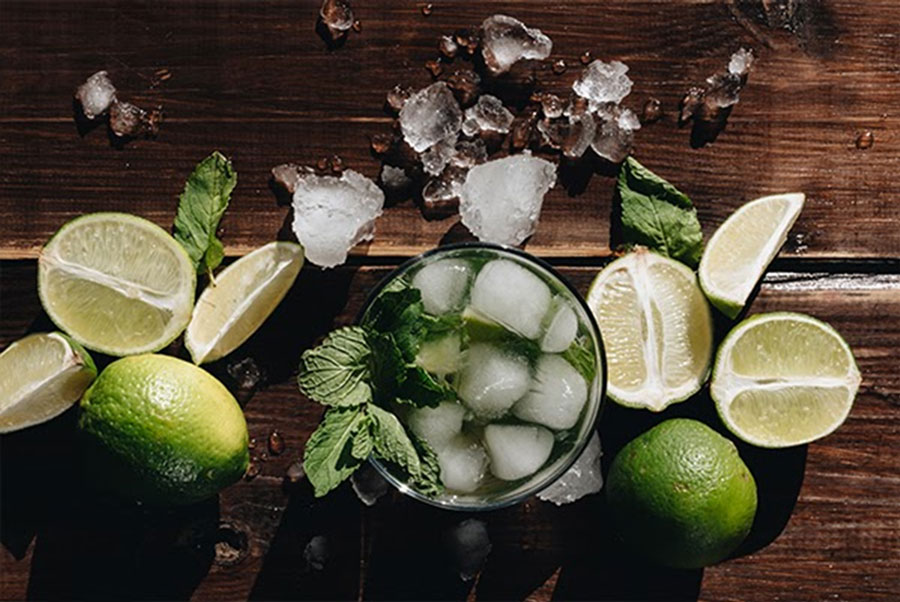
VODKA COCKTAILS
OK, let’s get to the good stuff! Vodka is great in spirit-forward cocktails such as martinis because it is typically very neutral in taste. For the same reason, it’s also great in mixed drinks where the other ingredients get to shine. And newer expressions have soft, unique characters that you may either want to showcase or use for complementing other elements.
So in order to break away from the typical vodka soda rut, we asked Veronika to share her favorite vodka cocktails with us, and we’ve of course added a couple of our own top picks, including classic vodka cocktails like the Bloody Mary.
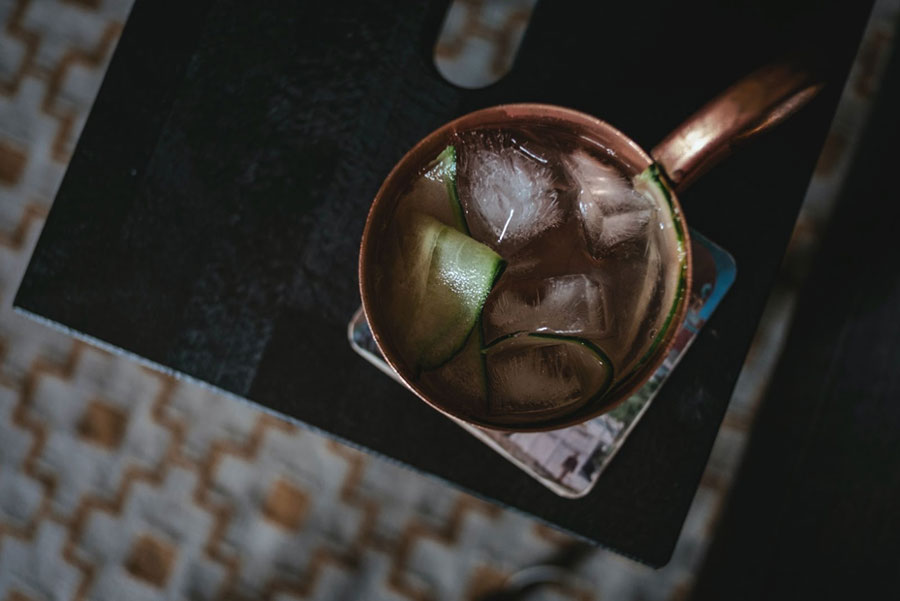
MOSCOW MULE
Let’s start with the original vodka cocktail that launched the spirit’s popularity in the States. This is a great “gateway” into vodka drinks if they’re not your thing yet. Mixing delicious, slightly spicy ginger beer and lime, a neutral vodka allows the other ingredients to shine in this refreshing cocktail.
MULE INGREDIENTS:
- 2 oz Vodka
- 4-6 oz Ginger Beer
- .5 oz Fresh Lime Juice
MULE INSTRUCTIONS:
- Add vodka and lime juice to a copper mug or highball glass. Give it a quick stir.
- Add fresh ice.
- Top with ginger beer to fill. Stir, and garnish with a lime wedge.

VODKA GIMLET
Traditionally made with gin, this is another martini-style cocktail that offers a little sweetness thanks to simple syrup.
GIMLET INGREDIENTS:
- 2 oz of Vodka
- 1 oz Fresh Lime Juice
- 1 oz Simple Syrup
GIMLET INSTRUCTIONS:
- Add all ingredients to a Boston cocktail shaker with ice.
- Shake to chill and dilute.
- Strain with a Hawthorn strainer into a Nick and Nora glass, and garnish with a lime slice.
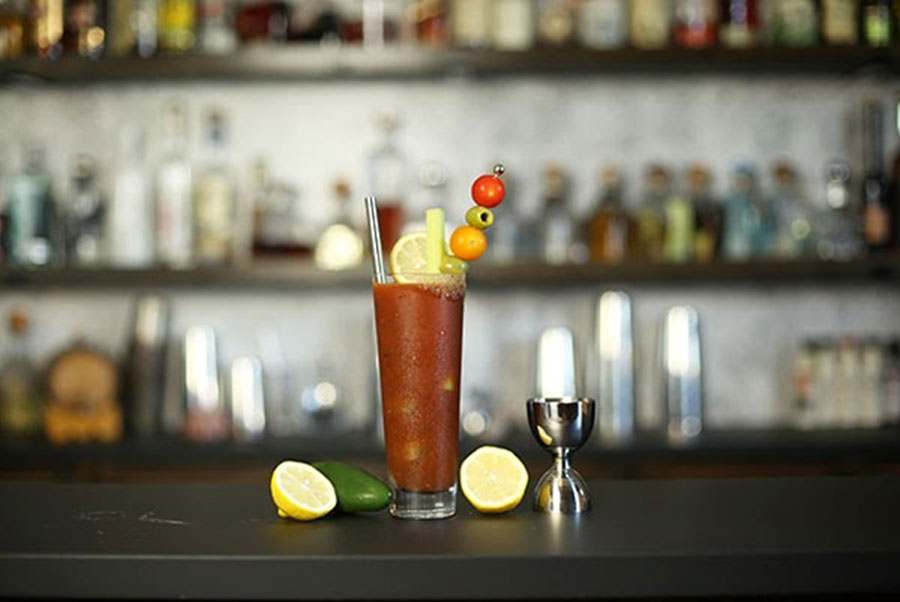
Photo Copyright A Bar Above 2021
BLOODY MARY
We couldn’t leave out the classic vodka cocktail that makes or breaks brunch! Below is our pick for a traditional Bloody Mary, but if you click the link above, you can also find our pepper-infused version (using a black pepper vodka is also very popular), in case you’re looking for options!
BLOODY MARY INGREDIENTS:
- 2 oz Vodka
- 4 oz Tomato Juice
- 1/4 oz Lime Juice
- 1/4 Worcestershire Sauce
- 1/4 Prepared Horseradish
- 1/8 oz (Barspoon) Pickled Jalapeno Juice
- 1/8 oz (Barspoon) Cholula Hot Sauce
- 2 dashes of Tabasco
- Pinch of Ground Black Pepper
- Pinch of Garlic Salt
- Pinch of Seasoned Salt
TRADITIONAL GARNISH OPTIONS:
- Lemon Wedge
- Celery Stalk
- Green Olives
- Slice of Bacon
BLOODY MARY INSTRUCTIONS:
- Build into a shaker tin and give a light shake (3-4 shakes) only to mix the ingredients properly.
- Roll the mixed ingredients over ice in a tall glass (typically pint glass).
- Add more ice as needed.

VESPER
Somewhat of a cousin to a traditional martini, this one is kind of cheating because it calls for a combination of vodka and gin, but it definitely got up-voted amongst all of us here at A Bar Above, so please forgive us and give it a try!
VESPER INGREDIENTS:
- 1.5 oz Gin
- .5 oz Vodka
- .25 oz Lillet Blanc
INSTRUCTIONS:
- Add all ingredients to a mixing glass.
- Add ice and stir to chill and dilute.
- Strain into a martini glass or cocktail coupe glass.
- Garnish with a lemon twist.

VODKA MARTINI
The martini is one of those classic cocktails that most spirit lovers will probably never outgrow. While a classic martini is made with gin, plenty of people love their vodka martinis.
The fun thing about making your way up to the martini is that you can try it a variety of ways to see what you like best.
For Veronika, she likes a very dry martini (little to no vermouth) and very cold (achieved by keeping a bottle of vodka and martini glass in the freezer). If you prefer yours less dry, you can do 2 ounces vodka and .5 ounce dry vermouth.
OUR VODKA MARTINI INGREDIENTS:
- 2.25 oz Vodka
- .25 oz Dry Vermouth
- 1-2 Dashes of Orange Bitters
OUR MARTINI INSTRUCTIONS:
- Add all ingredients to a mixing glass with ice.
- Stir well to chill and dilute.
- Strain into a chilled martini glass, coupe, or Nick & Nora.
- Express lemon oil across the cocktail and garnish with a twist of lemon. (You can garnish with a cocktail olive or onion if you prefer either of those to a lemon peel!)
You can also make your martini the Duke’s way, like Veronika does, by swirling a small amount of vermouth around the glass, rather than stirring in a full amount (a “vermouth wash“); then you pour the vodka directly into your chilled glass, avoiding any dilution (this also works for a gin martini, of course).
You can also make a “dirty martini” by adding olive juice.
Martinis seem easy since they have simple ingredients, but don’t let them fool you!
“You have to get every single step right in order to deliver the desired character and the taste of the martini. So obviously it has to be chilled the right way; I don’t like when it’s watered down. […] It all comes down to a chilled glass, what kind of vermouth you’re using, the garnish.” –Veronika Karlova

EXPERIMENT WITH YOUR VODKA COCKTAILS
But don’t limit yourself to traditional vodka cocktails! Be creative and have fun with whatever you decide to make– and definitely expect it to be different than what you’re used to.
If, for example, you sub vodka into an old fashioned, it will showcase the bitters and the sugar more. The whiskey brings a lot of depth to a traditional old fashioned, which vodka just can’t do in the same way. But if you want to try it, you could use a vintage-style potato vodka to play up those earthy flavors.
“I’ve probably tried so many types of cocktails with vodka– even an old fashioned with vodka, Negroni with vodka– everything. And it still tastes great. But it depends: Do we still call it a Negroni? Do we call it vodka Negroni? Do we call it [sic] vodka old fashioned?” –Veronika Karlova
WHICH VODKA TO USE IN COCKTAILS
When mixing cocktails, you want to pick the right spirit that will blend with your other ingredients. Not just any vodka will do.
Especially with “new,” character-full vodka, bartenders and consumers need to highlight those unique flavors. Vodka and cranberry juice isn’t going to cut it! You want to work with the inherent flavors of the spirit to complement its co-ingredients.
In general, a more neutral spirit or one with fruit or vanilla notes would blend better in your cocktail, depending on the other ingredients, of course. Grain- and even dairy-based alcohol would work better than, say, potato.
“Potato vodkas are not as favored to mix in cocktails as the grain-based vodkas ‘cause they have much more character, and sometimes it can interfere with some ingredients in the cocktail. You cannot hide that vegetal and earthy taste.” –Veronika Karlova
Potato vodka belongs in something like a traditional martini, where it can be the star of the show without competing against other ingredients.

COMMON QUESTIONS AND FACTS ABOUT VODKA
CALORIES IN VODKA
This is seriously the most highly-searched question on this topic, so I certainly have to address it. Because there are no carbs in vodka (unflavored), it’s a popular drink for people who still want to consume alcohol while trying to lose weight.
An 80-proof vodka (standard 40 percent alcohol) has about 60 calories per 1 oz— But remember, most drinks contain 2 oz* (or more) of alcoholic spirit. Plus, the higher the alcohol content, the higher the calorie count in any alcoholic beverage.
(Note: A lot of “calories per shot” indicators are only accounting for a 1.5-oz shot.)
A lower ABV spirit will be lower in calories— but also in flavor. A higher ABV spirit has more body but also more calories– Just like with food, the more calories, the richer and more delicious the taste!
And, despite its association with being the spirit of choice for a number of diets, it has about the same amount of calories as any other spirit, minus about 5-10 calories per ounce.
The real issue with any cocktail is the mixer you use. Your favorite cocktail may fool you into a false sense of security. Let’s take the vodka-cranberry for example: Unsweetened cranberry juice contains approximately 120 calories per serving and a whopping 31 grams of sugar– Yikes!
If you want to have mixed drinks and avoid weight gain, your best bet is to stay away from sugary mixers (including all juices and regular soda) and use soda water with your spirit of choice– And no, tonic water is not the same! Its caloric content is about 125 calories per 12 oz bottle, with 32 g of sugar. So put down that vodka tonic, stat!
SUGAR CONTENT
Speaking of sugar… While vodka typically does not contain sugar, some flavored vodkas do add it to create that super-sweet quality. It’s not common per se (Stoli says its Razberi version, for example, contains zero sugar), but it’s not unheard of.
The coconut version of Ciroc Vodka is reported to have 2.3 grams of carbs/sugar, and there is an infamous Reddit post that indicates Burnett’s whipped cream flavor has over 8 grams of carbs, although the link to their nutritional value is (in)conveniently unavailable now. So check the details of your chosen brand if you’re trying to cut sugar!

SO WHAT SHALL IT BE, DEAR VODKA DRINKER?
What’s your favorite vodka cocktail? Are you a new convert? We’d love to hear all about your vodka adventures– And if you make a vodka old fashioned, you’ll have to let us know in our Facebook community group!
Also tag us in your creations on Instagram, especially if you use our barware! And speaking of barware, we have you covered for all your professional and at-home bartending needs, so don’t forget to visit our shop and pick up everything you need to make your new favorite vodka cocktails.
“Be open-minded. Don’t be scared to try everything because, the more you try, your palate gets used to it, and it opens up. It develops, and you kind of find yourself recognizing new flavors, new taste, obviously within the vodka spirit, the vodka category. So I always say, if you have a chance to try different base vodkas, you know potato, grain, […] whey, […] corn […] so I always say try to taste different styles, and then hopefully you’ll recognize the quality and that vodka is not all the same. And then try experimenting in the cocktails, what works with what kind of cocktail. You just have to find what you like because we all have different tastes, you know, we all like different things.” –Veronika Karlova



